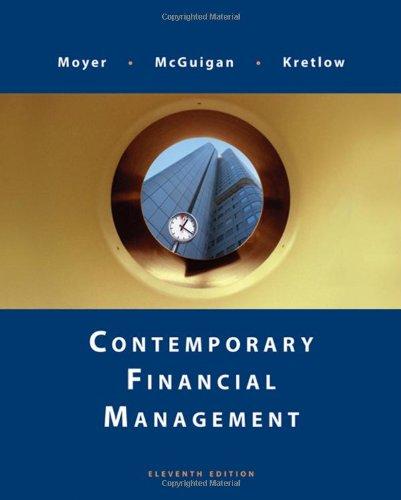Bond yields One year ago Carson Industries issued a 10-year, 12% semiannual coupon bond at its par value of $1,000. Currently, the bond can be
Bond yields
One year ago Carson Industries issued a 10-year, 12% semiannual coupon bond at its par value of $1,000. Currently, the bond can be called in 6 years at a price of $1,060, and it now sells for $1,150.
What is the bond's nominal yield to maturity? Do not round intermediate calculations. Round your answer to two decimal places. % What is the bond's nominal yield to call? Do not round intermediate calculations. Round your answer to two decimal places. % Would an investor be more likely to earn the YTM or the YTC?
What is the current yield? (Hint: Refer to Footnote 7 for the definition of the current yield and to Table 7.1.) Round your answer to two decimal places. % Is this yield affected by whether the bond is likely to be called?
If the bond is called, the current yield and the capital gains yield will remain the same but the coupon rate will be different.
If the bond is called, the current yield will remain the same but the capital gains yield will be different.
If the bond is called, the current yield and the capital gains yield will remain the same.
If the bond is called, the capital gains yield will remain the same but the current yield will be different.
If the bond is called, the current yield and the capital gains yield will both be different.
What is the expected capital gains (or loss) yield for the coming year? Use amounts calculated in above requirements for calcuation, if reqired. Round your answer to two decimal places. Enter a loss percentage, if any, with a minus sign. % Is this yield dependent on whether the bond is expected to be called?
If the bond is expected to be called, the appropriate expected total return will not change.
The expected capital gains (or loss) yield for the coming year depends on whether or not the bond is expected to be called.
The expected capital gains (or loss) yield for the coming year does not depend on whether or not the bond is expected to be called.
If the bond is expected to be called, the appropriate expected total return is the YTM.
If the bond is not expected to be called, the appropriate expected total return is the YTC.
Bond yields One year ago Carson Tndustries issued a 10-year, 12% semiannual coupon bond at its par value of $1,000. Currently, the bond can be called in 6 years at a price of $1,060, and it now sells for $1,150. a. What is the bond's nominal yield to maturity? Do not round intermediate calculations. Round your answer to two decimal places. What is the bond's nominal yield to call? Do not round intermediate calculations. Round your answer to two decimal places. Would an investor be more l to earn the YTM or the YTC? Sclect b. What is the current yield? (Hint: Refer to Footnote 7 for the definition of the current yield and to Table 7.1.) Round your answer to two decimal places. Is this yield affected by whether the bond is likely to be caled? I. IT the bond is caled, the current yield and the capital gains yield will remain the sae but the coupon rate wil be different. 11. the bond ls caled, the current yield will remain the same but the capital gains yield will be different. IT. If the bond is caled, the current yield and the capital gains yield will remain the same. IV. If the bond is caled, the capital gains yield will remain the same but the current yield wall be different. V. If the bond is caled, the current yield and the capital gains yield wall both be different. Select- C. What is the expected capital gains (or loss) yield for the coming year? Use amounts calculated in above requirements for calcuation, if reqired. Round your answer to two decimal places. Enter a loss percentage, if any, with a minus sign Is this yield dependent on whether the bond is expected to be called? I. IT the bond is expected to be called, the appropriate expected total return wil not change. II. The expected capital gains (or loss) yield for the coming year depends on whether or not the bond is expected to be called. T. The expected capital gains (or loss) yield for the coming year does not depend on whether or not the bond is expected to be called. IV. If the bond is expected to be called, the appropriate expected total return is the YTM. V. If the bond is not expected to be called, the appropriate expected total return is the YTC. -Select-Y
Step by Step Solution
There are 3 Steps involved in it
Step: 1

See step-by-step solutions with expert insights and AI powered tools for academic success
Step: 2

Step: 3

Ace Your Homework with AI
Get the answers you need in no time with our AI-driven, step-by-step assistance
Get Started


